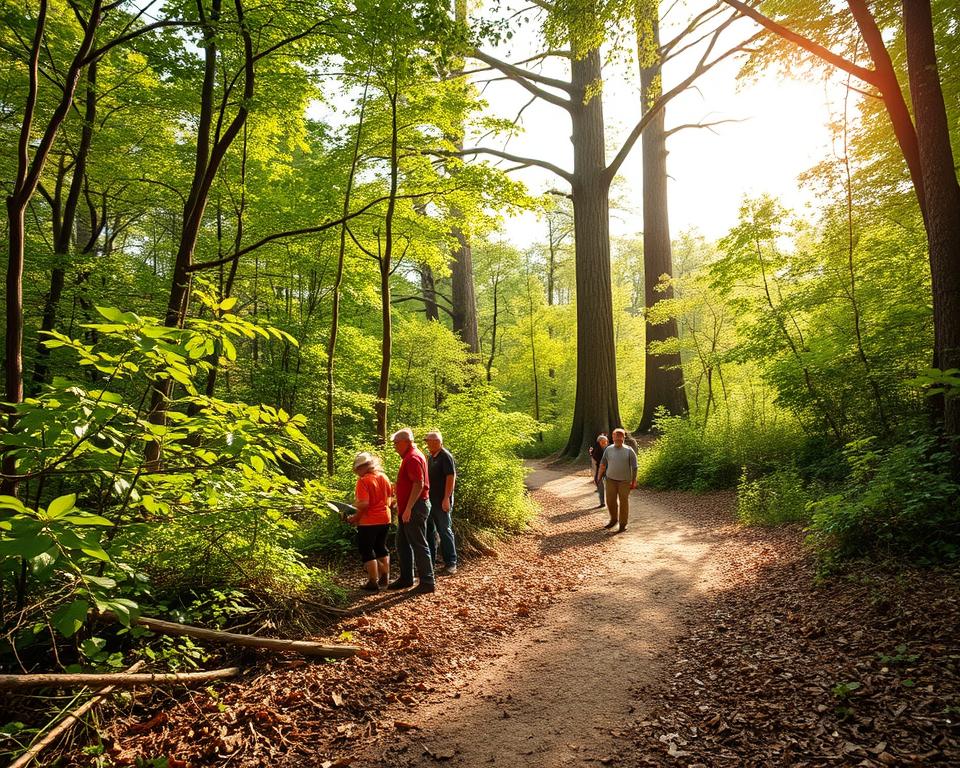Professional Tips: Clear Paths in Forest Grounds
Did you realize almost eighty percent of homeowners with woodland property rarely explore beyond their lot? This figure highlights the critical requirement for effective trail clearing and upkeep. Clearing routes and trails in wooded areas not only enhances accessibility but also improves security and wayfinding. The following piece will explore professional methods and perspectives from seasoned trail builders.
They will provide ways to craft properly-planned trails that optimize your outdoor area’s usefulness while preserving its ecological integrity. Uncover the primary factors for land clearing services near me and methods for efficient forest grounds upkeep solutions. Such can make your experience through your outdoor surroundings more enjoyable.
Essential Summaries
- Grasping the importance of clearing trails for accessibility and safety.
- Evaluating site conditions to define the purpose of your paths.
- Using the right tools for effective trail clearing.
- Selecting appropriate surfaces that match with landform.
- Adopting eco-friendly practices when clearing trails.
- Recognizing common errors to steer clear of during the path-opening process.
Why Clearing Trails in Forested Grounds Matters
Maintaining open routes in forest areas is vital for multiple purposes. It greatly enhances accessibility, enabling it easier to navigate thick foliage. This allows property owners and visitors to fully enjoy the landscape. This clearing also facilitates various activities like walking, bird watching, or simply enjoying the outdoors.
Enhancing Accessibility
Open trails not only enable movement; they also strengthen our link with nature. By improving approachability, owners make available the open air to a wider audience. Such benefits is beneficial for personal use or group gatherings, fostering discovery and valorization of the surroundings.
Enhancing Safety and Direction
The significance of safety on forest paths is paramount. Defined paths provide clear navigation and reduce hazards from rough ground, hidden obstacles, or sudden plant growth shifts. Property owners commit in creating secure paths, boosting assurance in outdoor exploration.

Designing Your Forest Path
Effective path planning requires a thorough knowledge of the landscape. It’s about assessing ground and location conditions. Knowing the trail’s goal is also key, as it shapes construction and maintenance.
Evaluating Terrain and Site Conditions
When assessing ground, multiple factors are critical. These include:
- Ground compositions that affect drainage and stability
- Slope degree affecting ease of access and safety
- Current plant life that may need clearing or preservation
By assessing these elements, trails can withstand various climatic factors. They also accommodate frequent pedestrian use. This approach guarantees the path is durable and honors the ground’s natural features.
Setting the Trail Objective
Path planning achievement depends on a well-defined purpose. Think about the activities the trail will serve, such as:
- Leisurely strolling and outdoor appreciation
- Entry for upkeep or land management
- Chances to watch fauna and learning
Understanding the trail’s goal guides many decisions. Such understanding includes the path’s breadth and building supplies. Identifying the path’s goal is crucial for crafting a path that fulfills its requirements.
Tools Needed for Trail Clearing
Effective trail opening demands the right gear for different jobs. The appropriate tools boost productivity and safety, streamlining the procedure. The selection between hand tools and motorized equipment depends on the project’s size, ground, and amount of debris.
Fundamental Handheld Tools
Hand tools are key for precision and versatility in clearing dense zones. Essential tools include:
- Loppers: Ideal for cutting through heavy branches and bushes.
- Hand saws: Perfect for detailed slicing on trees.
- Ho-dads: Handy for digging and forming water channels.
Such instruments provide a manual approach, essential for sensitive areas where machinery could harm.
Power Equipment for Efficiency
For large-scale trail opening projects, motorized devices are a game-changer. They make the task speedier and more efficient. Key equipment include:
- Chainsaws: Perfect for cutting down large timber and cutting through dense underbrush.
- Brushcutters: Fast for removing thick turf and smaller shoots.
Motorized tools reduces opening time, making it suitable for extensive zones. Secure operation is imperative to prevent injuries.
Strategies for Clearing Paths and Trails in Wooded Property
Opening paths and trails in forest areas demands thoughtful preparation. It is vital to mediate functionality with eco-friendliness. Efficient vegetation management ensures the natural ecosystem’s harmony while establishing functional pathways. This equilibrium is key to a pleasant outdoor encounter.
Removing Excess Growth
Targeted removal techniques are essential when tackling overgrowth. Manual implements allow for accurate extraction of undesirable plants without damaging the ecosystem. This method promotes the flourishing of desired plants while controlling invasive ones. Regular maintenance prevents resurgence, enhancing trail safety and accessibility.
Creating a Sustainable Pathway
A sustainable route layout is more than just looks; it includes choosing materials that reduce soil loss and enhance drainage. These strategies respect the environment and lessen environmental harm. Using native stones or reclaimed wood bolsters long-term durability and ecological harmony. Careful planning achieves a equilibrium between functionality and environmental preservation.
Selecting Ideal Trail Surfaces
Selecting the right path surface is critical for both usability and longevity. The decision between natural and artificial coverings affects upkeep, comfort, and trail longevity. Knowing the various materials and their fitness for your terrain is key to establishing an optimal route.
Natural vs. Man-Made Surfaces
Natural surfaces, such as gravel, crushed stone, or mulch, are often more affordable. They integrate well with the environment, facilitating drainage and a organic appearance. In contrast, synthetic covers like concrete pavers are more durable and appropriate for heavy use. Every type has its advantages and disadvantages, based on the intended application and environmental conditions.
Choosing the Right Materials for Your Terrain
Choosing the right resources involves considering ground composition, water requirements, and cost constraints. Below is a simple guide to popular options:
| Material | Advantages | Disadvantages | Cost per Square Foot |
|---|---|---|---|
| Gravel | Inexpensive, Good drainage | May need frequent replenishing | $1 – $3 |
| Crushed Stone | Stable surface, Organic appearance | Can be difficult to walk on in wet conditions | $2 – $5 |
| Wood Chips | Eco-friendly, Soft underfoot | Needs frequent topping up | $1 – $2 |
| Concrete Pavers | Tough, Low maintenance | More expensive initially | $5 – $15 |
Carefully selecting trail surface materials guarantees your routes are functional and compliment the area’s natural beauty.
Constructing Elevated Walkways
Creating paths in wooded areas demands thoughtful planning of level shifts. This is crucial for even crossings across different landforms and maintaining trail accessibility over time. Building overpasses for trails is often required, mainly when spanning wet areas or low-lying ground.
Identifying When to Add Height Variations
Height in path design is often due to irregular ground. Major drops or rises necessitate builds like bridges or turnpikes to preserve path soundness. This approach aids prevent ground washout and ensures user safety, vital for both casual hikers and serious nature lovers.
Materials for Building Bridges Over Wet Areas
The choice of supplies for turnpikes and bridges is key for their security and durability. Timber beams, masonry units, or treated lumber can offer the necessary strength against weight and environmental factors. It’s important to select supplies that are water-resistant to prevent degradation and support subsequent modifications.
Trail Maintenance and Upkeep
Keeping paths safe and accessible demands continuous care. Frequent checks help identifying problems early, ensuring visitors have a good experience. It’s essential to upkeep trails throughout the year, as weather changes can impact them. This section will outline a comprehensive maintenance checklist and the advantages of hiring expert path care solutions.
Seasonal Maintenance Checklist
A thorough checklist helps trail owners keep their paths in top shape all year. Key activities include:
- Clearing debris such as fallen branches and foliage.
- Checking trail surfaces for damage, following bad weather.
- Checking water channels to avoid flooding.
- Fixing soil washout by supplementing gravel as needed.
- Updating markers and signs for straightforward direction.
Expert Path Care Providers
For those needing expert help, specialized trail maintenance services are a excellent option. They offer:
- Thorough trail assessments by experienced experts.
- Specialized repairs and renewal of high-traffic trails.
- Using dedicated machinery for better path treatment.
- Implementing sustainable methods to extend path longevity.
Hiring expert trail maintenance saves your time for other outdoor pursuits. It also introduces expert knowledge.
Beautifying Trail Borders
Landscaping is key to rendering paths visually appealing. By carefully selecting flora and elements, you can create an welcoming space. This not only draws visitors but also aids local habitats. The right vegetation for trails provide beauty and maintain environmental stability.
Incorporating Flora for Aesthetic Appeal
When planning trail landscaping, picking the right plants is essential. Local species are ideal as they organically blend with the environment. They require less maintenance and offer habitat for local wildlife. Mix blooming flora, bushes, and turf for a diverse, attractive ambiance around trails.
Employing Borders and Rock Edges
Edging materials like stones and bricks are important for path form. They define the path and add its design. These elements prevent soil erosion and provide a clean contrast with vegetation. Using different textures and hues can render the trail more interesting.
Eco-Friendly Path Preparation
Path opening tasks should prioritize environmental sustainability. Responsible ground care practices help protect the area’s ecological integrity. This approach makes sure paths harmonize with the natural world peacefully.
Eco-Friendly Clearing Methods
Embracing sustainable approaches in trail opening is critical. Minimal-impact techniques minimize soil erosion and protect habitats. Selective clearing and eco-friendly materials reduce land disturbance.
Understanding the ground and vegetation is crucial. It supports responsible clearing and enhances path usability.
Impact on Local Wildlife and Flora
Wildlife impact assessments are vital in path construction. They assist measure the task’s effect on local fauna and flora. This allows for required changes before building begins.
Spotting critical habitats avoids environment disturbance. This balance ensures a healthy environment for every form of life.
Path constructors can create sustainable routes with careful planning. This commitment to environmental sustainability and fauna protection enhances outdoor experiences. It balances recreational activities with nature’s respect.
Pitfalls to Avoid in Path Opening
Engaging in path clearing demands steering clear of common errors to prevent long-term problems. Identifying these errors allows for improved preparation and execution. By emphasizing simple trail layout and addressing water flow, one can avoid extensive maintenance needs.
Over-Complicating the Path Design
Path design often succumbs to the pitfall of overengineering path design. Numerous users believe elaborate layouts make paths more attractive. Yet, straightforwardness is often the secret to effectiveness. Simple routes enhance wayfinding and maintenance, reducing hurdles.
Avoidable turns and elaborate features can lead to trail design errors. These problems hinder usage and navigation, making trails less pleasant.
Ignoring Drainage Needs
Ignoring drainage challenges in trails can have serious outcomes. Proper drainage planning prevents water accumulation, which can wash out paths and harm landscapes. Adequate drainage solutions are essential for a long-lasting path.
Making sure proper runoff from the trail protects the route and preserves the environment. This enables for a more pleasant nature excursion.
In Closing
Trail opening is essential for those who desire to completely enjoy their forest grounds. It enhances ease of access and security, making outdoor spaces pleasant for everyone. Forest paths offer more than mere scenic appeal; they offer opportunities for recreation and education about the environment.
Effective planning and execution are crucial in trail clearing. Assessing ground and selecting the right materials are vital for establishing lasting paths. Regular maintenance keeps these paths safe and open, promoting a ongoing link with nature.
By understanding the ideas discussed here, you can design and upkeep paths that serve both practical and recreational purposes. Adopting forest paths can transform your property into a haven for exploration, rest, and appreciating the environment.

